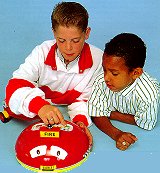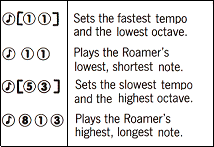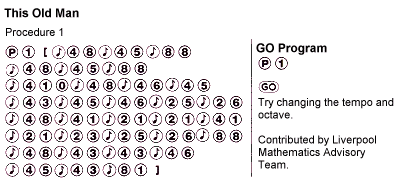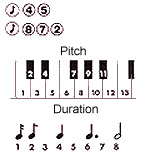
|
Feedback Form


MUSICAL ROAMER

"A-roaming, a-roaming,
Since roaming's getting me to sing,
I'll GO some more a roaming For you today!"
| Roamer Music Instructions.
Press the key marked |
|
| Length of Note | Pitch |
|---|---|
| 1 Semiquaver 2 Quaver 3 4 Crotchet 5 6 Dotted crotchet 7 8 Minim |
1 C 2 C# 3 D 4 D# 5 E 6 F 7 F# 8 G 9 G# 10 A 11 A# 12 B 13 C 14 Silent note (rest) |
Reg Fletcher, Hampshire's County General Inspector for Music, takes a look at Roamer's musical capability.
The variety of articles in recent issues of GO has demonstrated clearly the virtually infinite potential of children's and teachers' imagination in exploiting Roamer's capabilities, enabling learning to be supported at all stages of pupils' development. Roamer has been characterised as an explorer, plotter, aeroplane and delivery truck. By challenging children's understanding of organising sequences and patterns of operation, they have been required to consider and test hypotheses by planning and executing numbers of sometimes complex manoeuvres and procedures.
To date GO has not explored Roamer's considerable musical potential; the following few examples may serve to illustrate this ability. They endorse the declarations of the adapted sea song that national curriculum expectations in a number of subjects, including those emergent in national curriculum music. They may also offer evidence of achievement in relation to a number of different levels of attainment in a variety of subjects.
Pupils observing the relatively simple pattern of operation of the demonstration program will quickly analyse the sequence of its various elements. If it is repeated, they will recognise them as a sequence and will readily recall the chain of events. Imagining the recollected actions of Roamer is part and parcel of memory development skills. This set of skills is crucial to several aspects of musical development in terms of making and understanding music.

The following simple task explores the formation of basic sequences involving sounds.
- Imagine the Roamer as an emergency vehicle with
a two-tone siren. Map out a route to follow with the simple requirement
that the two-tone siren is sounded at every junction crossed or when
making a turn.
Children could try various combinations of two sounds and the effects of different durations and registers (octave): high, low or medium. Which sounds are the best match for the real emergency vehicles in your area?
The commands for two-tone siren sounds might be entered individually or as a procedure, exploring the use of Roamer's repeat function.
Changing Tempo and Octave Roamer sounds may be played at one of five tempos and one of three octaves.
To change tempo or octave press
 then
then  .
Press a number between 1 and 5 for the tempo. 1 is fastest,
5 is slowest. Press a number between 1 and 3 for the octave.
1 is lowest and 3 is highest. Press
.
Press a number between 1 and 5 for the tempo. 1 is fastest,
5 is slowest. Press a number between 1 and 3 for the octave.
1 is lowest and 3 is highest. Press  again.
again.
 A
more complex task could be to imagine the Roamer as a mobile cake-sales
van using the tune of "Hot Cross Buns" as a call sign. Programming the
tune is quite a demanding task. If it is done in step-time, entering
it note by note as a long chain of commands, it is likely that mistakes
will be made in the entry sequence. Children are quick to recognise
the similar and different patterns of notes which make up the tune and
can enter each pattern as a procedure. It is then much simpler to call
the procedures in turn. The repetitions of some notes and the upward
and downward patterns of others will provide a wide range of challenges
to different members of a group working together to plan their solution
to the problem.
A
more complex task could be to imagine the Roamer as a mobile cake-sales
van using the tune of "Hot Cross Buns" as a call sign. Programming the
tune is quite a demanding task. If it is done in step-time, entering
it note by note as a long chain of commands, it is likely that mistakes
will be made in the entry sequence. Children are quick to recognise
the similar and different patterns of notes which make up the tune and
can enter each pattern as a procedure. It is then much simpler to call
the procedures in turn. The repetitions of some notes and the upward
and downward patterns of others will provide a wide range of challenges
to different members of a group working together to plan their solution
to the problem.
About Music Music making is essentially to do with organising and arranging patterns of sound. Sounds are characterised by their timbre, i.e. tone colour, but can be changed in only three distinct ways:
- Volume (loudness or amplitude)
- Duration (length)
- Pitch (high, low or changing frequency)
Roamer concentrates on duration and pitch.
Duration will contribute to effects of time: speed (fast or slow), rhythm (patterns of long and/or short sounds) and pulse or beat and metre - a regular pattern that falls into groups of several regular beats or combinations of them.Pitch or frequency can remain the same or change by moving upward or downward. The movement of pitched notes will be perceived as repetitions, steps (small changes of pitch) or leaps (wider changes of pitch). Patterns of pitched notes in a song will usually form a recognisable set or scale defined as a "key" or "tonality".
Programming the tune entails using a wide range of features. By the time it is completed, most of the children will not only have gained from completing it successfully but will also have acquired considerable experience of the contrast between the leaping intervals in one procedure and the patterns of note rows running upward or downward. The ordering of these patterns will reveal fully the structural elements of the tune.
 Throughout
all this, recalling the tune by singing and/or playing, either in
reality or in the imagination, will reinforce a wide range of musical
concepts and extend aural and melodic memory.
Throughout
all this, recalling the tune by singing and/or playing, either in
reality or in the imagination, will reinforce a wide range of musical
concepts and extend aural and melodic memory.The melody which appears at beginnipg of this article could also be keyed into Roamer although it cannot be played whilst on the move as most children might like. It can only be keyed in note by note in step time: it does not have recurring phrases or cells of melody but uses more varied and complex patterns of leaps and runs. These extend over a greater range and require the use of Roamer's lower register. Such similarities as there are within the tune are to do mainly with written patterns and harmonic structures, attributes which Roamer cannot store independently.

Hopefully this brief glimpse of some of Roamer's musical potential may inspire a variety of other challenges. Let us know.
| Be aware when programming long tunes Roamer could run out of memory. This state is indicated by a warning sound similar to the one obtained when you press CM. |
| Back |
|---|
